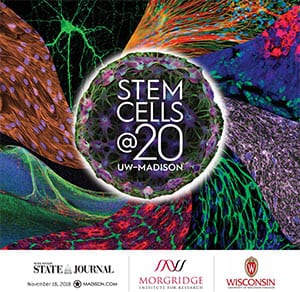There’s a flurry of activity in the Discovery Building’s teaching labs during the Rural Summer Science Camp.
Students huddle around a gelatin model of a heart, poking and prodding, while discussing the best way to use stem cells to repair heart injuries. Another group is moving colorful liquid through channels in Lego-like blocks, testing how liquid can move against the forces of gravity under the right circumstances.
Graduate students explain how activities relate to their day-to-day lab work and high school teachers encourage experimenting students.
The camp has served more than 500 rural high school students and teachers since 2007 from nearly 80 Wisconsin high schools. Campers learn about stem cell science, medical engineering, bioinformatics and more while immersing themselves in the work of researchers at the Morgridge Institute for Research and UW–Madison.
“Bringing the big world into our small communities is a huge positive,” says Georgi Kapalczynski, a teacher with the Wausaukee School District. “Some of our areas are so poverty stricken, so traumatized, it’s good for these students to have this opportunity. Where they might not normally branch out and feel secure enough to explore … some of these kids can now say, ‘I can do this.’”
Darlington High School science teacher Brent Whalen agrees.
“This camp is a confidence builder,” Whalen says. “Some of the students have a fear of the unknown, fear of what’s different. To some, Madison might seem like a big, scary city. But then they get here and understand they can do it. They could be that researcher.”
Students isolate and analyze DNA, test potential therapies on cancer cells and see how various drugs affect heart rate by testing beating cells in a Petri dish.
The Morgridge Institute runs the camp in partnership with the Wisconsin Rural Schools Alliance, and, thanks to generous sponsors, it is offered free to participants.
“It’s a chance to give your kids opportunities they’re not going to get anywhere else,” says Whalen, who attended camps in 2014 and 2018. “Last time I attended the camp, we saw heart cells beating in a video presentation. This time, we used the heart cells ourselves and experimented with them.”
While some camp activities require specialized materials or equipment, others are adaptable for hometown classrooms. Erin Sincox, a Sevastopol High School teacher, says a camp activity on soil testing—with ties to antibiotic resistance—offers a perfect opportunity.
“We have a school forest area, and it’d be great to take the students out there for soil testing,” Sincox says. “Taking an interdisciplinary approach, I could teach them how physical science, chemistry and physics apply to these biological systems.”
The camp’s value is clear, says Michael Dunbar, a Prentice High School science teacher.
“If a teacher asks why they should bring their kids here, the answer is it’s going to make you a better teacher,” Dunbar says. “It’s inspiring to see what’s being done. You can tie experiences back into your classes, and meeting with people who are actively doing research makes it all more real and valuable.”
Stem Cells at 20

Today, research is booming worldwide, including hundreds of scientists at UW–Madison and the Morgridge Institute.
Read more about the remarkable Wisconsin stem cell story in excerpts from a special section created in partnership with the Wisconsin State Journal.
